Finally! A calm, summer weekend in Europe…
The hills are no longer alive with the sounds of a Greek press conference in Athens or news update from Brussels blasting through the local cable channel. Greece is done (for now) and Europe wrote a big check. Stock prices bounced, peripheral debt yields declined and even the Greek banks will open someday this week; time for many Europeans to grab a hike in the Alps or some Mediterranean sand before the next crisis pops up.
Here in the U.S., all eyes turned to the Q2 reporting season, which started off with 3 big bangs: Google (NASDAQ:GOOGL), Netflix (NASDAQ:NFLX) and Banks…
One of the highlights this week was the upbeat sentiment surrounding bank earnings despite the lack of any notable surprises. Money center names NYSE:BAC +8.4%, NYSE:C +7.7% and NYSE:JPM +3.2% outperformed. However, NYSE:CMA (4.6%) was hit by a reserve boost for its oil and gas exposure. GOOG +26.9% was a big gainer in the Internet group, with the focus on better expense discipline. Strong subscriber growth boosted NFLX +18%. NASDAQ:EBAY +6.3% was another standout, as core Marketplaces growth accelerated from Q1 and momentum in Payments continued. In semis, results and guidance from NASDAQ:INTC +1% were better than feared, though there continued to be some skepticism. NASDAQ:FCS (9.7%) reported a big miss, noting weaker demand from some mobile (Samsung (KS:005930)) and appliance customers. NYSE:PM +4.5% boosted tobacco, as price/mix drove an earnings beat and better guidance commentary. In the rail space, better pricing and cost control helped offset volume headwinds at NYSE:CSX +0.2%, while NYSE:KSU +4.3% fared significantly better. Among the multi-industrials, both NYSE:GE +3.7% and NYSE:HON +3.1% beat. In managed care, NYSE:UNH +1.4% was out with a beat and raise, but bogged down by an NYSE:MLR miss. In the chemicals group, NYSE:CYT (5.2%), NYSE:SHW (4.4%) and NYSE:CE (3.7%) all came under outsized pressure following their results
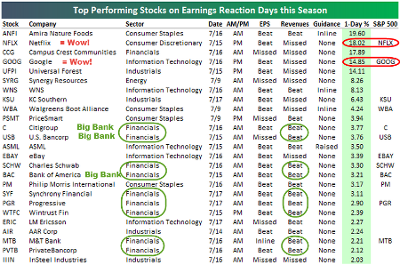
(BespokeInvestmentGroup)
After several lackluster quarterly earnings reports, Google hit it out of the park on Thursday. Given the strength of the move, Google looks to now be the large, open-ended growth story that must be involved in every portfolio discussion…
Google announced strong results and its stock responded in kind. In the hours that followed, it gained nearly a Benjamin, going from $580 to $673. This $65 billion increase in market value was the second highest single-day gain of all time, eclipsed only by Cisco (NASDAQ:CSCO) at the peak of the Bubble in 2000.
Google helped their cause with the debut of CFO Ruth Porat, who was able to speak Wall Street’s language. Former CFO, Patrick Pichette – super competent by all accounts – spoke French. The words Porat whispered into investors’ ears were that, 1) Google is focused on making money on mobile, and; 2) The company is showing discipline. The hyperbolic positive reaction to Ms. Porat, who joined Google from Morgan Stanley (NYSE:MS) on May 26, was as much for the promises of tomorrow as the performance of the past.
Google’s quest for world domination has been fueled by a vision for a digital empire that is in many ways borderless. Give us your tired, your poor, your huddled masses… but also your smartphones, your apps, your cars, your homes, and your data. Much of Google’s success has been driven by the creation of “open” systems that derive value from the access and participation of third parties. Launched in 2007, Google’s open mobile operating system, Android, has become a dominant global platform, powering over 78% of smartphones shipped in 2015. Android documentation and technical specifications are widely available to the public and it has become the operating system of choice for technology companies and developers seeking ready-made, low-cost, and customizable software. Today, Android powers everything from smartphones to wearable devices, televisions, and cars
Google is a large weight in the indexes. Congrats to the few large portfolio managers that went double and triple weighted their benchmarks:
- Davis Venture = 6.1% Google
- Oakmark Select = 5.6%
- T.Rowe Growth = 5.5%
- T.Rowe Blue Chip = 4.7%
- Fidelity Contrafund = 4%
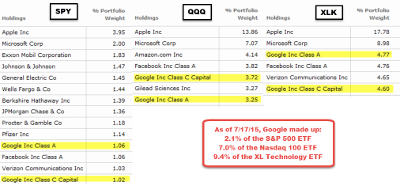
There were some other interesting earnings tidbits that came out last week…
- Lower fuel prices helped CSX to a beat… Investors jumped on board CSX Corp. (NYSE:CSX), after the largest railroad operator on the U.S. east coast reported second-quarter profits ahead of estimates. The Jacksonville, Florida-based company reported profits of $553m, or 56 cents a share, compared with $529m, or 53 cents a share, in the year ago period. Sales fell 6 percent to $3.06bn. Analysts on Wall Street had forecast earnings of 53 cents a share on sales of $3.1bn, writes Mamta Badkar. The company said lower fuel prices and savings from efficiency initiatives resulted in a 9 percent drop in expenses and resulted in a record operating income of $1bn for the quarter.
- Schlumberger’s comments were notable for all oil service stocks… “As we enter the second half of the year, our visibility still remains limited. In terms of oil supply, the first signs of flattening North America production have appeared, while OPEC marketed supply has been increased once again. Non-NAM, non-OPEC production weakened in the first half of the year, driven by falls in Brazil and Mexico, with further softening expected as lower investment levels start to take full effect. The latest supply data, together with a strong outlook for global oil demand, point to a tightening of the global supply-demand balance, even with additional supply from Iran. E&P investment in North America is now expected to fall by more than 35% in 2015, driven by lower land activity and increased pricing pressure. We believe that the North American rig count may now be touching the bottom, and that a slow increase in both land drilling and completion activity could occur in the second half of the year.”
- BB&T (NYSE:BBT) Bank noted that the home purchase market is really picking up… “look, purchase activity is really picking up; new home construction is up substantially and new home purchases is up; we’re seeing a shift toward high percentage of purchases versus refis. So I think, you can think about it in terms of the steady up, not dramatic up, steady to up.”
- Not all banks had good things to say, especially if you have a big energy lending book… Comerica (CMA) Inc.’s second-quarter earnings missed expectations on Friday, as the Dallas-based bank set aside more money for potential credit losses in the energy industry and said it expects to continue doing so for the rest of the year. The bank’s shares dropped more than 6%. Falling oil and gas prices have pinched the energy industry over the past year, and many industry observers have predicted the trouble would soon trickle down to banks that lend to companies in the sector.
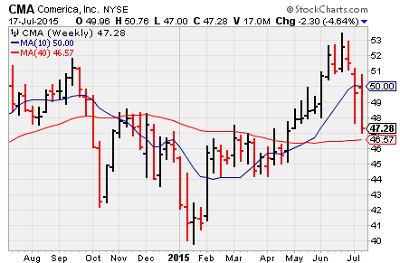
Energy price troubles are not only affecting some stocks and bonds, but look at the Canadian dollar about to test 6 year lows and now 25% off the 2011 highs. Canadian hockey players finally enjoying the benefit of getting paid in U.S. dollars while having their expenses in Canadian dollars. You should also grab the forex benefit and line up that fall trip to Vancouver Island or Montreal…

China went all in on attempting to calm fears about its Equity market last week…
800LB GORILLA– China has created what amounts to a state-run margin trader with $483 billion of firepower, its latest effort to end a stock-market rout that threatens to drag down economic growth and erode confidence in President Xi Jinping’s government – China Securities Finance Corp. can access as much as 3 trillion yuan of borrowed funds from sources including the central bank and commercial lenders – The money may be used to buy shares and provide liquidity to brokerages.
And China still has some very big fans, like Hugh Hendry of Eclectica…
“China is very, very much like the Europe of 2012,” said Hendry, 46. “There is a textbook response. Banks can do alchemy. They can take that bad paper and use it as collateral and you get free money to put back into the economy.” Hendry said the ingredients were in place for a “longer term bull market” in China as an erosion in company margins reverses. “The mystery is why it is so distrusted by us, by the investor community,” he said.
There were many new highs set during the week by the major indexes and ETFs…
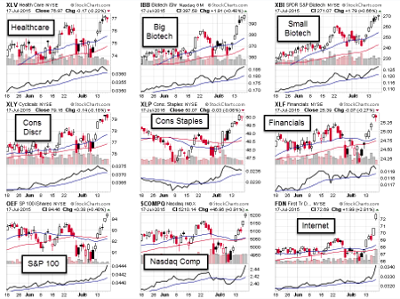
For the week, the Tech and Financials win was helped by their better than expected sector earnings. Energy and Materials pulled up the rear hurt by falling commodity prices…
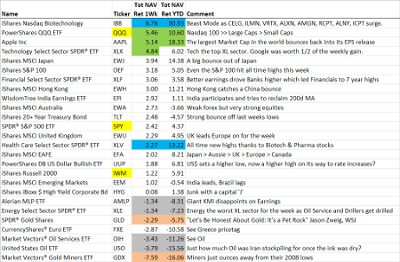
The week’s move in tech and biotech helped the Growth style boxes move even farther ahead of the pack…
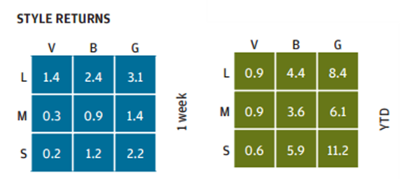
If you need a graph to show that European financial concerns have waned…
Euroarea peripheral debt having a good run. Spanish and Italian 10-year yields well below 2%

Meanwhile, European economic data points continue to mend…
European car-sales growth accelerated to the fastest pace in 5 1/2 years in June, as Volkswagen AG (XETRA:VOWG), PSA Peugeot Citroen and Ford Motor Co. (NYSE:F) attracted customers with new models and the region’s economy expanded. Registrations rose 15 percent to 1.41 million autos from 1.23 million a year earlier, the Brussels-based European Automobile Manufacturers’ Association, or ACEA, said Thursday in a statement. The jump was the biggest since a 16 percent surge in December 2009, when governments in the region offered incentives on trade-ins of older cars to help the industry recover from the global recession.
The economy of the 19 countries using the euro is in its longest stretch of growth since the 2008 worldwide credit crunch, while unemployment in the U.K. is at close to a seven-year low. The ACEA more than doubled its 2015 regional car-market expansion forecast a week ago.
Barron’s is looking for further good news out of Europe…
Europe is getting a leg up from macroeconomic factors. In addition to persistently weak oil prices, the euro is retreating in value once again, as the monetary policies of the European Central Bank and Federal Reserve diverge. Friday, the euro traded at $1.084, down 2.3% on the week. As the timing of an anticipated Fed interest-rate hike nears—the Fed is expected to act later this year—the dollar is likely to strengthen further against the common currency. A weaker euro is good news for euro-zone manufacturers, as it makes their goods cheaper when denominated in other currencies.
Trade data also are encouraging. Euro-zone exports were up 5% in the first five months of 2015, compared with the same period a year earlier. Even the International Monetary Fund seems upbeat on the euroarea’s prospects. In a July report, it confirmed its projections for 1.5% growth this year in gross domestic product, and 1.7% growth in 2016. At the same time, it reined in forecasts for U.S. growth.
Another reminder that Europe is out of favor…
Proportion of buy ratings for European stocks well below average – good sign that we could be far from the top…
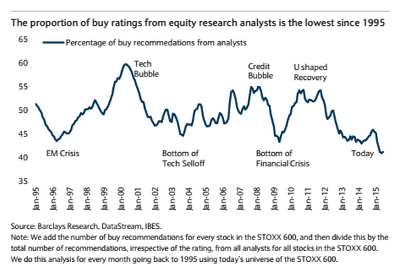
Over in Japan: Fat Sumo Wrestlers are Out, Ripped Samurai Warriors are In…
Last year, the Japan Exchange Group (TOKYO:8697) launched the Nikkei 400, which selects companies based not merely on size, but on factors such as return on equity, operating profit, and corporate governance. The brainchild of Abe’s party, the 400 is called by some the shame index. Not making it in is the corporate equivalent of failing the yearly belly-fat test. Consider Amada Holdings (TOKYO:6113), a cash-stuffed toolmaker that missed the cut. It promptly announced that it would begin paying out half its profit as dividends and put the other half toward stock buybacks while pursuing acquisitions. Reducing cash drives return on equity higher, all else held equal. Amada also said it would hire outsiders for its board. It hasn’t made it into the 400 yet, but its shares are up 22% this year.
Japan’s massive pension funds have slashed investments in bonds, sharply increased stock holdings, and signaled that they, too, will use factors like return on equity and corporate governance to guide their selections. Last year, Japan introduced a new stewardship code to give shareholders more say. Just last month, new corporate-governance rules went into effect that prompt companies to hire more independent directors and cut down on cross-shareholdings, the practice of companies holding stock in one another for the purpose of stifling dissent, rather than pursuing returns. Ahead of the new rules, about 60% of Japanese companies last year sold down their cross-holdings.
Also last year, 58% raised their dividends, putting payments at a record. Goldman Sachs (NYSE:GS) expects 69% to hike payouts this year. It notes that companies that have raised payments as a percentage of profits or announced new buyback plans have been rewarded with market-beating stock performance.
Lots of talk about High Yield Bonds this year; here is some more data to consider if you are looking at the asset…
Sorry guys, high yield is still not over-valued on a broad survey of metrics.
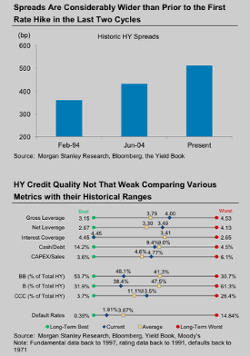
(Morgan Stanley)
And then there is the gold commodity asset class, which continues to lose its shine…
Many people may have bought gold for the wrong reasons: because of its glittering 18.7% average annual return between 2002 and 2011, because of its purportedly magical inflation-fighting properties, because it is supposed to shine in the darkest of days. But gold’s long-term returns are muted, it isn’t a panacea for inflation, and it does well in response to unexpected crises—but not long-simmering troubles like the Greek situation. And you will put lightning in a bottle before you figure out what gold is really worth.
With greenhorns in gold starting to figure all this out, the price has gotten tarnished. It is time to call owning gold what it is: an act of faith. As the Epistle to the Hebrews defined it forevermore, “Faith is the substance of things hoped for, the evidence of things not seen.” Own gold if you feel you must, but admit honestly that you are relying on hope and imagination.
Recognize, too, that gold bugs—the people who believe in owning the yellow metal no matter what—often resemble the subjects of a laboratory experiment on the psychology of cognitive dissonance.
Great chart reminding that gold’s weakness is the U.S. dollar’s strength…
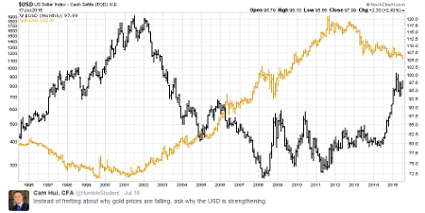
Byron Wien’s ‘Smartest Man’ in Europe suggests focusing on innovation to find outperformance…
“It is not easy to make money these days. In the past, if you had the right asset allocation, you could do well for institutional investors. Now most asset classes are fully valued. The bond market is expensive, equities are not cheap anywhere, gold is dead; other commodities are in bear markets, the emerging markets are generally not attractive, China is dangerous, and Europe and Japan are reasonably fully priced. As I said last year, the only way to make serious money is by carefully investing in innovation. You can make a modest return in equities in the major markets – I agree with you that the U.S. market will end the year higher than it is now. But if you want to make real money investing, you will have to do it by picking stocks in technology and biotechnology, and I would emphasize the latter.”
There is going to have to be a whole lot more innovative companies to invest in if Calpers is going to make its 30 year goal of 7.5%/yr…
The California Public Employees’ Retirement System, the largest pension in the U.S., said it earned 2.4 percent last fiscal year, below its target rate as financial-market turbulence depressed stock and bond returns. The $300 billion fund earned 1 percent on public-equity holdings and 1.3 percent in fixed-income investments, said Ted Eliopoulos, chief investment officer. Real estate returned 13.5 percent, while private equity gained 8.9 percent. Calpers must average at least 7.5 percent a year to match its assumed rate of return or turn to taxpayers to make up the difference. Calpers is among pensions under pressure to boost investment returns, as their unfunded liabilities tripled to almost $2 trillion from 2004 through 2013, according to Moody’s Investors Service.
Chicago has found a different way to attack its pension underfunding…
Now that Cook County has increased sales tax, sales tax in Chicago is 10.25%, which is the highest in the county.
Business travelers now using Uber more than Taxis. Next up, Car Rentals…
Today, expense software company Certify released its latest data on how business travelers are spending money. Their report found that for the first time, travelers used Uber more than traditional taxis. Uber accounted for 55 percent of ground transportation receipts submitted by employees versus 43 percent for taxis. (About 1 percent of receipts were for Lyft rides and another 1 percent for other ride-hailing services.) That’s a reversal from last quarter, when Uber had 46 percent of the receipts versus 53 percent for taxis. The spike in Uber use is also taking a chunk out of the rental car business, according to the report. In the second quarter of 2014, 55 percent of people rented a car while traveling on business; that figure dropped by 10 percent during the same period this year.
Disclaimer: The information presented here is for informational purposes only, and this document is not to be construed as an offer to sell, or the solicitation of an offer to buy, securities. Some investments are not suitable for all investors, and there can be no assurance that any investment strategy will be successful. The hyperlinks included in this message provide direct access to other Internet resources, including Web sites. While we believe this information to be from reliable sources, 361 Capital is not responsible for the accuracy or content of information contained in these sites. Although we make every effort to ensure these links are accurate, up to date and relevant, we cannot take responsibility for pages maintained by external providers. The views expressed by these external providers on their own Web pages or on external sites they link to are not necessarily those of 361 Capital.
